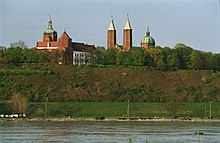Duchy of Mazovia
The Duchy of Mazovia (Polish : Księstwo Mazowieckie ) emerged as a feudal state in the course of the 12th century on the territory of today's Mazovia after the division of the Kingdom of Poland into partial duchies in 1138 by the will of Duke Bolesław III. Crooked mouth .
Mazovia was originally a tribal territory that included the stretch of land on the right bank of the Vistula in the vicinity of Płock . The origin of the name is not entirely clear, it is assumed to be related to the name of the cupbearer of King Mieszko II. Lambert , who was called Masos, Maslao, Masław († 1047) and who lived in the years after the king's death in 1034, previously appropriated the area. Since the 10th century it belonged to the Piast state and formed one of the provinces with the center in Płock.
As a result of the will of Bolesław III. Wrymouth was united under the rule of Duke Bolesław Kraushaar Masovia with Kujawien and the central Polish dominions Sieradz and Łęczyca to a duchy. During the reign of Duke Konrad I (r. 1200–1247), Mazovia became independent from the Krakow seniorate , and after 1313 it was divided into three partial duchies with the centers of Płock, Czersk - Warsaw and Rawa Mazowiecka .
The Dukes of Mazovia became vassals of the United Kingdom of Poland from 1351 . After the male line of the Mazovian Piast line died out due to the death of Duke Janusz III. The duchy fell back to the Kingdom of Poland as a settled fief in 1526. The territory was converted into a voivodeship on December 27, 1529 and thus administratively incorporated into the kingdom directly, with which it remained until the partitions (1772, 1793, 1795).
The memory of the duchy was preserved in the following centuries both in the name of the voivodeship and in the title of the Polish rulers. In his title , King Sigismund II. August claimed the following areas:
Sigismundus Augustus Dei gratia rex Poloniae, magnus dux Lithuaniae, nec non terrarum Cracoviae, Sandomiriae, Siradiae, Lanciciae, Cuiaviae, Kijoviae, Russiae, Woliniae, Prussiae, Masoviae , Podlachiae, Culmensiae dominaniae, haemoniae, Pomeroniae etc., Elbingensis .
Remarks
- ↑ Kujawien and Dobrin were occupied by the Teutonic Order at that time and only finally fell to Poland with the Peace of Kalisch in 1343.
literature
- D. Dymek: Historia i kultura Mazowsza do 1526 r. Wyższa Szkoła Rozwoju Lokalnego, Warszawa 2005, ISBN 83-7204-436-8 .
- D. Dymek: Udzielne Księstwo Mazowieckie: 1247–1381: zarys dziejów. Wydawn. MOBN, Warszawa 1996, ISBN 83-900647-7-4 .
- FA Kozłowski: Dzieje Mazowsża za panowania książat . Nakl i druk S. Orgelbranda, Warszawa 1858.


